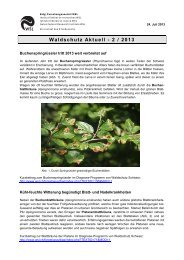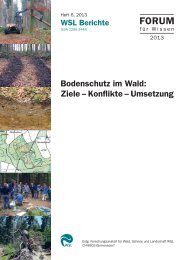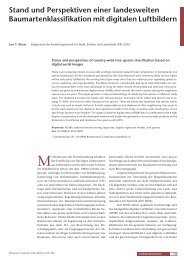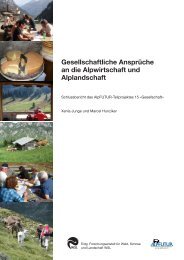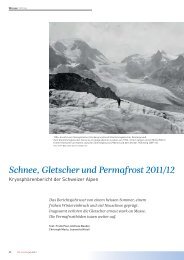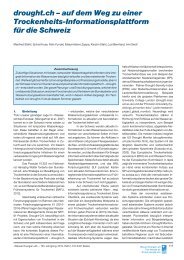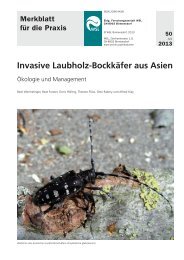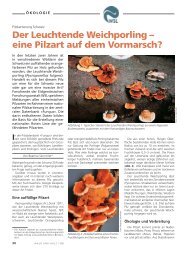Ecology and management of the spruce bark beetle Ips ... - WSL
Ecology and management of the spruce bark beetle Ips ... - WSL
Ecology and management of the spruce bark beetle Ips ... - WSL
Create successful ePaper yourself
Turn your PDF publications into a flip-book with our unique Google optimized e-Paper software.
Mortality experienced during winter can be<br />
attributed to both biotic <strong>and</strong> abiotic factors. A mortality<br />
rate <strong>of</strong> roughly 50% for I. typographus <strong>beetle</strong>s<br />
overwintering in fallen trees was attributed to<br />
air temperatures down to 10 8C (Faccoli, 2002).<br />
Immature stages were more affected than adult<br />
B. Wermelinger / Forest <strong>Ecology</strong> <strong>and</strong> Management 202 (2004) 67–82 69<br />
Table 1<br />
Selected data from research on <strong>Ips</strong> typographus published between 1990 <strong>and</strong> 2002<br />
Feature<br />
Biology<br />
Data Section<br />
Minimum temperature for development 6–8.3 8C 3<br />
Minimum temperature for oviposition 11.4 8C 3<br />
Optimum temperature for development <strong>and</strong> oviposition 29–30 8C 3<br />
Fecundity Up to 80 eggs/female 3<br />
Sex ratio (% females) 50% (retrogradation)<br />
50% (progradation)<br />
3<br />
Overwintering mortality 50% 3<br />
Optimum breeding density 500 maternal galleries m 2<br />
3<br />
Optimum harem size Three females 3<br />
Minimum temperature for flight (threshold) 16.5 8C 4<br />
Optimum flight temperature 22–26 8C 4<br />
Main flight time Noon, early afternoon 4<br />
Minimally required number <strong>of</strong> days with temperatures ><br />
flight threshold for successful attack on living trees<br />
3–4 days in a row 4<br />
Active flight distance<br />
Natural enemies<br />
>500 m 6<br />
Most important insect groups Clerid <strong>beetle</strong>s, dolichopodid flies,<br />
pteromalid wasps, braconid wasps<br />
7<br />
Prey consumption 7<br />
Clerid larvae Approximately 50 scolytid larvae<br />
Clerid adults Approximately 100 scolytids<br />
Dolichopodid larvae 5–10 scolytid larvae<br />
Mode <strong>of</strong> host/prey finding 7<br />
Parasitoids Volatiles<br />
Clerids<br />
Host susceptibility<br />
Bark <strong>beetle</strong> pheromones<br />
Host defense mechanisms Stored resin, toxins, deteriorated food quality,<br />
wound reaction<br />
8.1<br />
Trees at high risk South, west exposition, sunlit, >70–100 years old,<br />
trees with heart rot<br />
8.2<br />
Radius <strong>of</strong> higher risk <strong>of</strong> attack around infestation<br />
Outbreaks<br />
100 m 6<br />
Causes <strong>of</strong> outbreaks/prolongation <strong>of</strong> outbreaks Windthrow, drought, high temperatures, snow/ice break 9<br />
Peak abundance <strong>of</strong> I. typographus in windthrow areas<br />
Management<br />
2nd to 3rd summer after storm 9<br />
Optimum period for salvage harvesting <strong>of</strong> windthrown logs Between infestation <strong>and</strong> emergence <strong>of</strong> first generation 10.1<br />
Estimated catch rates <strong>of</strong> pheromone traps 3–10% <strong>of</strong> population 10.2<br />
Optimum exposition <strong>of</strong> pheromone traps South 10.2<br />
Catch efficiency <strong>of</strong> baited trap trees relative to pheromone traps Up to 30 10.2<br />
Size <strong>of</strong> phytosanitary buffer zone around reserves 500 m (100–1500 m) 10.4<br />
Bark <strong>beetle</strong> mortality with machined de<strong>bark</strong>ing<br />
Section numbers refer to <strong>the</strong> text. For references see text.<br />
93% 10.1<br />
<strong>beetle</strong>s. The emergence <strong>and</strong> migration <strong>of</strong> <strong>beetle</strong>s<br />
<strong>of</strong> monovoltine generations were found to depend<br />
on <strong>the</strong> geographical latitude: nor<strong>the</strong>rn populations<br />
emerged later <strong>and</strong> migrated less frequently before<br />
overwintering than those <strong>of</strong> sou<strong>the</strong>rn origin (Forsse,<br />
1991).



